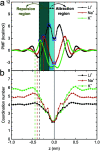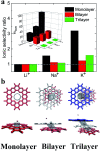Ion transport through a nanoporous C2N membrane: the effect of electric field and layer number
- PMID: 35558907
- PMCID: PMC9088869
- DOI: 10.1039/c8ra07795a
Ion transport through a nanoporous C2N membrane: the effect of electric field and layer number
Abstract
Ion transport through a two-dimensional membrane with nanopores plays an important role in many scientific and technical applications (e.g., water desalination, ion separation and nanofiltration). Although there have been many two-dimensional membranes for these applications, the problem of how to controllably fabricate nanopores with proper shape and size still remains challenging. In the present work, the transport of ions through a C2N membrane with intrinsically regular and uniformly distributed nanopores is investigated using all-atom molecular dynamic simulations. It was found that the monolayer C2N membrane possesses higher ion permeability compared to the graphene membrane because of its higher density of nanopores. In addition, it exhibits excellent ion selectivity under a low electric field due to the distinct dehydration capabilities and interaction behaviors (with the pore edges) of the different ions. Furthermore, we found that multilayer C2N membranes have weak ion selectivity, but show promising potential for desalination. The present study may provide some physical insights into the experimental design of C2N-based nanodevices in nanofluids.
This journal is © The Royal Society of Chemistry.
Conflict of interest statement
There are no conflicts to declare.
Figures






Similar articles
-
Controlling ion transport in a C2N-based nanochannel with tunable interlayer spacing.Phys Chem Chem Phys. 2020 Aug 7;22(29):16855-16861. doi: 10.1039/d0cp02993a. Epub 2020 Jul 15. Phys Chem Chem Phys. 2020. PMID: 32666963
-
Tunable C2N Membrane for High Efficient Water Desalination.Sci Rep. 2016 Jul 7;6:29218. doi: 10.1038/srep29218. Sci Rep. 2016. PMID: 27384666 Free PMC article.
-
Gas Separation Membranes with Atom-Thick Nanopores: The Potential of Nanoporous Single-Layer Graphene.Acc Mater Res. 2022 Oct 28;3(10):1073-1087. doi: 10.1021/accountsmr.2c00143. Epub 2022 Sep 13. Acc Mater Res. 2022. PMID: 36338295 Free PMC article.
-
Two-dimensional nanopores and nanoporous membranes for ion and molecule transport.Curr Opin Biotechnol. 2019 Feb;55:124-133. doi: 10.1016/j.copbio.2018.09.002. Epub 2018 Oct 12. Curr Opin Biotechnol. 2019. PMID: 30321759 Review.
-
Recent Developments in Nanoporous Graphene Membranes for Organic Solvent Nanofiltration: A Short Review.Membranes (Basel). 2021 Oct 18;11(10):793. doi: 10.3390/membranes11100793. Membranes (Basel). 2021. PMID: 34677558 Free PMC article. Review.
Cited by
-
Field-Dependent Dehydration and Optimal Ionic Escape Paths for C2N Membranes.J Phys Chem B. 2021 Jul 1;125(25):7044-7059. doi: 10.1021/acs.jpcb.1c03255. Epub 2021 Jun 11. J Phys Chem B. 2021. PMID: 34115497 Free PMC article.
References
-
- Wang L. Y. Wu H. A. Wang F. C. RSC Adv. 2017;7:20360–20368. doi: 10.1039/C7RA00890B. - DOI
LinkOut - more resources
Full Text Sources

